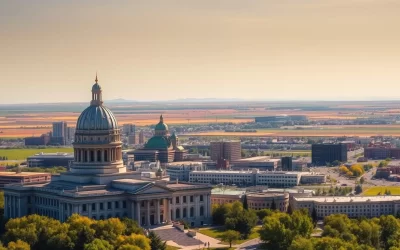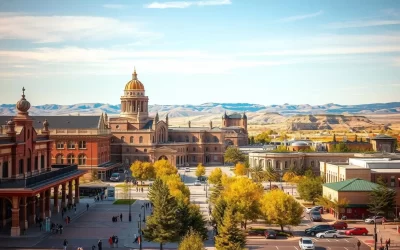Are you planning a trip to Saskatchewan, known for being Canada’s sunniest province? With approximately 2,500 hours of sunshine per year, this destination offers a unique experience across all four seasons. Understanding the climate and weather patterns is crucial for a well-planned trip.
The province’s temperate climate, situated between maritime and continental zones, means significant temperature variations throughout the year. From scorching summers to frigid winters, the time you choose to visit will greatly impact your travel experience.
Whether you’re drawn to summer festivals, fall foliage, winter adventures, or spring wildlife watching, this guide will help you navigate Saskatchewan’s weather to determine the perfect time for your visit based on your interests and comfort.
Understanding Saskatchewan’s Unique Climate
Saskatchewan’s climate is a fascinating mix of extremes, making it a unique destination for travelers. Located in the heart of Canada, the province experiences a continental climate characterized by significant temperature variations throughout the year.
Continental Climate Characteristics
Saskatchewan’s continental climate means it has large diurnal temperature ranges and low humidity for much of the year. This climate type is known for its extreme temperature fluctuations, a characteristic that Saskatchewan embodies.
Canada’s Sunniest Province
Saskatchewan is often referred to as Canada’s sunniest province, receiving ample sunlight throughout the year. This makes it an attractive destination for those seeking sunny weather.
Temperature Extremes to Expect
The province holds the record for Canada’s highest temperature, reaching 45°C in Midale and Yellow Grass. Conversely, the coldest temperature ever recorded was -56.7°C in Prince Albert. Such extremes are not everyday occurrences but are possible due to the province’s geography.
| Temperature Extreme | Location | Temperature (°C) |
|---|---|---|
| Hottest | Midale and Yellow Grass | 45 |
| Coldest | Prince Albert | -56.7 |
Travelers should be prepared for these temperature extremes, as well as for the possibility of winter temperatures plummeting below -40°C and summer heat waves pushing temperatures above 30°C for several days in a row, particularly in July and August.
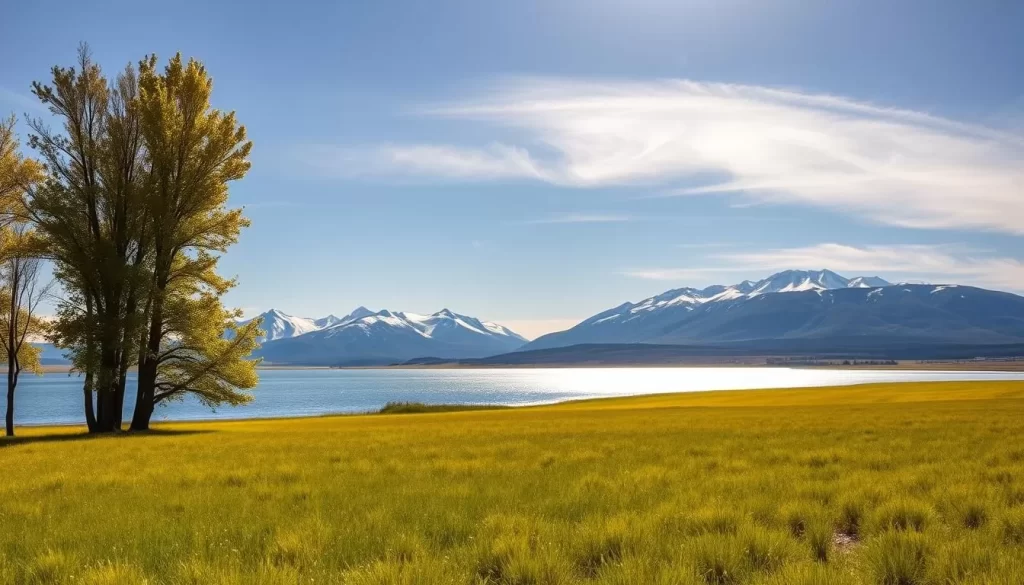
Understanding these climate characteristics is essential for planning a trip to Saskatchewan, ensuring that you’re prepared for the potential weather conditions, regardless of the month you visit.
Summer Glory: June to August
Saskatchewan’s summer glory is characterized by long days, warm temperatures, and a plethora of outdoor activities. This season is ideal for visitors who enjoy exploring the great outdoors.
Peak Temperatures and Sunshine Hours
During the summer months, Saskatchewan experiences peak temperatures and extended sunshine hours, making it an ideal time for outdoor enthusiasts. Daytime temperatures often reach the mid-20s to mid-30s Celsius (mid-70s to mid-90s Fahrenheit), providing perfect conditions for hiking, camping, and other outdoor pursuits.
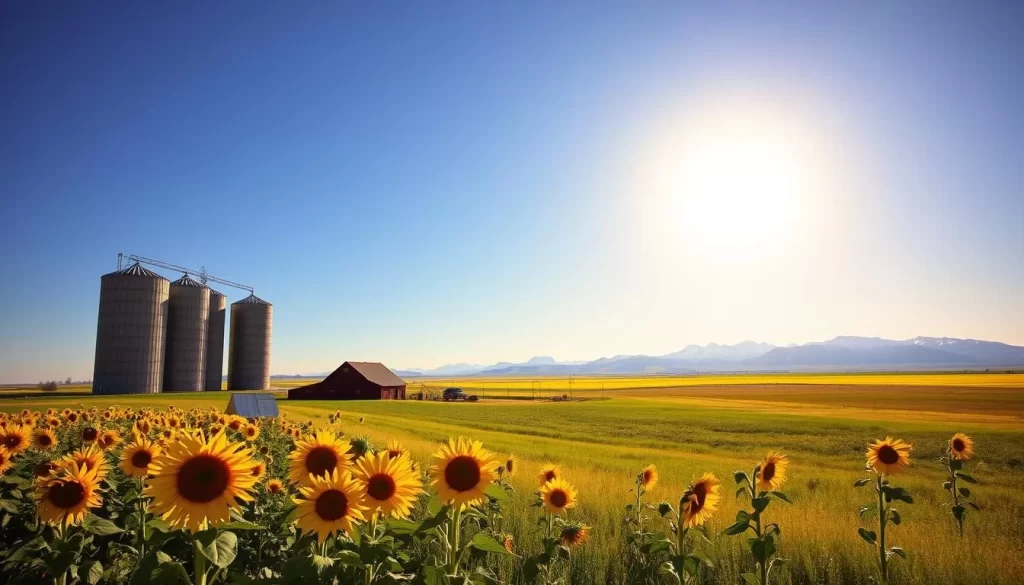
Summer Festivals and Events
Summer in Saskatchewan is not just about the weather; it’s also a time for vibrant festivals and events. The province hosts numerous cultural festivals, agricultural fairs, and outdoor concerts, showcasing the region’s rich heritage and community spirit. Visitors can enjoy events like the Saskatoon Folkfest and the Regina Folk Festival, among others.
Preparing for Summer Thunderstorms
While summer is generally warm and sunny, Saskatchewan can experience sudden thunderstorms. It’s essential to be prepared for these storms by carrying appropriate gear and staying informed about weather conditions. Visitors should also be aware of the potential for severe weather, including tornadoes.
Tornado Season Awareness
Saskatchewan is considered one of Canada’s most tornado-active regions, with an average of 12 to 18 tornadoes recorded annually. Visitors should be aware of the risks and take necessary precautions, especially during peak tornado season in June and July. The province has effective early warning systems in place, and visitors can stay safe by familiarizing themselves with local emergency procedures.
Saskatchewan’s unique blend of warm weather, outdoor activities, and cultural events makes it a fantastic destination during the summer season. By being aware of the potential for severe weather and taking appropriate precautions, you can have a safe and enjoyable trip to this beautiful place any year you visit.
Fall’s Golden Canvas: September to October
September and October are the best months to experience Saskatchewan’s fall beauty, with mild temperatures and fewer crowds. The fall season brings a unique charm to the province, transforming the landscapes into a kaleidoscope of autumn colors.
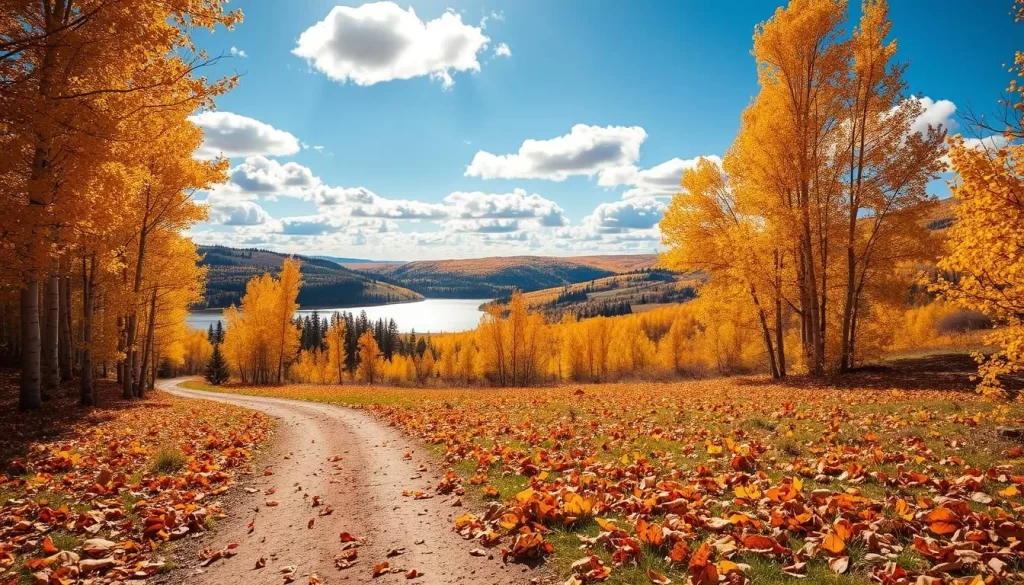
Mild Temperatures and Changing Landscapes
The fall season in Saskatchewan is characterized by comfortable temperatures, ranging from cool mornings to mild afternoons, making it ideal for outdoor activities. The changing foliage creates a picturesque backdrop for hiking, photography, and exploring the great outdoors.
Harvest Festivals and Agricultural Experiences
Fall is also a time for harvest festivals and agricultural experiences. Visitors can enjoy local produce, attend farm tours, and participate in seasonal events that celebrate the region’s rich agricultural heritage.
Fewer Crowds and Better Rates
One of the significant advantages of visiting Saskatchewan in the fall is the reduced number of tourists compared to the peak summer months. This means shorter wait times at popular attractions, easier access to accommodations, and more competitive rates. Many hotels and lodges offer discounts of up to 30% after the Labor Day weekend, making it an attractive time for budget-conscious travelers.
| Aspect | Summer | Fall |
|---|---|---|
| Crowd Levels | High | Low |
| Accommodation Rates | Peak Prices | 15-30% Discount |
| Weather | Hot | Mild |
| Activities | Peak tourist season activities | Harvest festivals, fall foliage |
Visiting Saskatchewan during the fall season offers a unique blend of natural beauty, cultural experiences, and economic advantages, making it the best time to visit for those looking for a more relaxed and affordable travel experience.
Winter Adventures: November to February
If you’re prepared for the cold, winter in Saskatchewan can be a magical time to explore Canada’s vast and varied landscapes. The weather is cold and there will probably be snow, but this doesn’t stop you from enjoying the cities and numerous outdoor activities that come with the season.
Embracing the Cold: Temperature Expectations
Temperatures can be quite low, often dropping below -20°C (-4°F) in the peak winter months. However, this is also the best time for winter sports like skiing and ice fishing.
Winter Activities and Festivals
Despite the chill, winter is a great time for travel in Saskatchewan, with numerous festivals and events. You can enjoy winter activities such as dog sledding, snowmobiling, and ice skating. The season also hosts various winter festivals that celebrate the unique culture and heritage of the region.
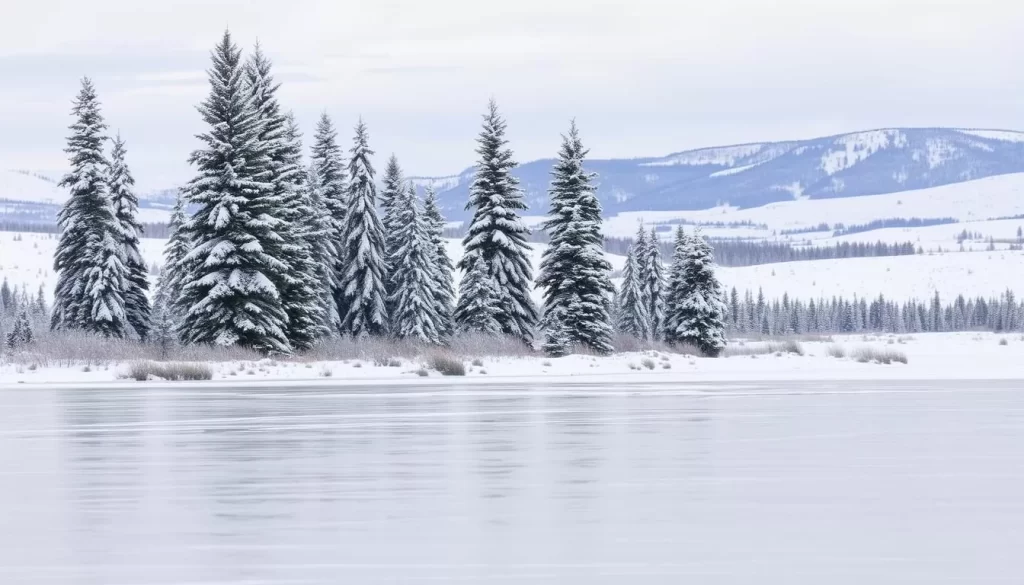
Chinook Winds and Weather Variations
Saskatchewan’s weather can be quite variable, with Chinook winds sometimes bringing sudden temperature changes. Understanding these weather patterns can help you plan your travel itinerary more effectively.
Safety Tips for Winter Travel
To make the most of your winter trip, safety should be your top priority. Here are some key considerations:
- Always carry a winter emergency kit in your vehicle.
- Check highway reports before traveling between communities due to potentially hazardous conditions.
- Dress in layers to maintain warmth.
| Activity | Location | Best Time |
|---|---|---|
| Skiing | Various ski resorts | December to February |
| Dog Sledding | Multiple tour operators | January to March |
| Ice Skating | Outdoor rinks across the province | December to February |
By being prepared and informed, you can have a wonderful time exploring Saskatchewan during the winter months.
Spring Renewal: March to May
As winter’s chill begins to dissipate, Saskatchewan transforms into a vibrant landscape, signaling the arrival of spring. This transitional period, spanning from March to May, brings a unique blend of weather patterns and activities that cater to various interests.
Transitional Weather Patterns
March is still quite cold, making it a relatively slow season for travel, except for spring break, which usually occurs toward the end of the month. Many visitors come to Canada during this time to ski or visit sugar shacks for maple syrup tasting. As temperatures begin to rise, the province experiences a shift in weather patterns, making it an ideal time to enjoy outdoor activities.
Spring Activities and Wildlife Viewing
Spring is a great time to explore Saskatchewan’s natural beauty, with many provincial parks and nature centers offering maple syrup demonstrations. You can witness the province’s diverse wildlife, including various bird species, as they emerge from their winter habitats.
Maple Syrup Season
Saskatchewan may not be known for commercial maple syrup production like eastern Canada, but it has its own spring sugaring traditions. Manitoba maple trees are tapped in late March and April when daytime temperatures rise above freezing while nights remain cold. You can experience the short but sweet sugaring season, typically lasting 3-4 weeks, at various provincial parks and nature centers. Indigenous communities share traditional knowledge about spring sap collection from various tree species, including birch. Local producers create small-batch maple products that can be found at farmers’ markets and specialty shops during this season.
Spring festivals in communities with Ukrainian heritage often incorporate maple syrup into traditional spring celebrations, connecting visitors with both the natural cycles of the land and the cultural heritage of Saskatchewan’s diverse communities.
Saskatchewan, Canada: Best Months for a Weather-Savvy Trip
Saskatchewan’s diverse climate means that the best time to visit depends on your preferences. Whether you’re an outdoor enthusiast, a fan of winter sports, or someone who enjoys mild temperatures, Saskatchewan has something to offer throughout the year.
May-June: Ideal for Outdoor Enthusiasts
The late spring and early summer months are perfect for those who love the outdoors. With mild temperatures and long days, May and June are ideal for hiking, biking, and exploring the province’s natural beauty. You can enjoy the vibrant festivals and events that take place during this period, making it a great time to experience the local culture.
September: Perfect Balance of Weather and Crowds
September offers a perfect balance of pleasant weather and smaller crowds, making it an excellent month for travel. The summer heat has dissipated, and the fall foliage is just beginning, creating a picturesque landscape. It’s an ideal time to visit the cities and enjoy outdoor activities without the peak season rush.
January-February: For Winter Adventure Seekers
For those who enjoy winter sports and activities, January and February are the best months to visit Saskatchewan. The province transforms into a winter wonderland, offering excellent conditions for cross-country skiing, snowmobiling, and ice fishing. At this point in the year, you can also enjoy winter festivals and take advantage of lower accommodation rates.
Each of these periods offers a unique experience, so you can choose the best time to visit based on your interests and preferences. Whether you’re looking for outdoor adventures, cultural experiences, or simply a change of scenery, Saskatchewan is a great destination at any time of the year.
- January and February offer quintessential Saskatchewan winter experiences.
- May and June are ideal for outdoor enthusiasts.
- September provides a perfect balance of weather and smaller crowds.
Planning Tips for Every Season
Understanding the seasonal variations in Saskatchewan is essential for travelers to make the most of their trip. As you plan your visit, consider the time of year and how the province’s climate might impact your travel plans.
Essential Packing Lists by Season
Packing appropriately is crucial for a comfortable trip. In the summer, bring light clothing and sun protection, while in the winter, warm, layered clothing is a must. Spring and fall require versatile packing to accommodate the variable temperatures.
Weather Monitoring Resources
Staying informed about the weather can help you navigate Saskatchewan’s changing conditions. Utilize local weather forecasts and consider downloading weather apps to stay up-to-date during your travel.
Sun Safety in the Sunniest Province
Saskatchewan is known as Canada’s sunniest province, making sun safety a top priority. Be sure to pack sunscreen with a high SPF, wear protective clothing, and seek shade when necessary, especially during peak sun hours.
Transportation Considerations
When traveling in Saskatchewan, be aware of the seasonal conditions and the province’s vast geography. Winter travel requires vehicles equipped with winter tires, and drivers should be cautious of strong crosswinds, particularly in open prairie areas. Additionally, be mindful of wildlife collisions, which peak during dawn and dusk hours.
- Ensure your vehicle is equipped for the season.
- Be prepared for variable road conditions, especially on rural and secondary roads.
- Keep your fuel tank above half full, particularly during winter travel.
By considering these factors, you can ensure a safe and enjoyable trip to Saskatchewan, regardless of the time of year you visit.
Conclusion
With its four-season climate, Saskatchewan caters to different interests and preferences throughout the year. Whether you’re planning a time visit for outdoor adventures or cultural experiences, understanding the province’s seasonal variations is key.
The best time to visit Saskatchewan largely depends on your interests. For general travel, May-June and September offer a great balance of weather and fewer crowds. If you prefer summer activities and festivals, July-August is ideal, while January-February is perfect for winter adventures.
Saskatchewan’s distinct seasons and varying months provide a unique experience, with the province being Canada’s sunniest. With proper preparation, any time of the year can be the perfect time to discover Saskatchewan’s natural beauty and charm.
The above is subject to change.
Check back often to TRAVEL.COM for the latest travel tips and deals.



